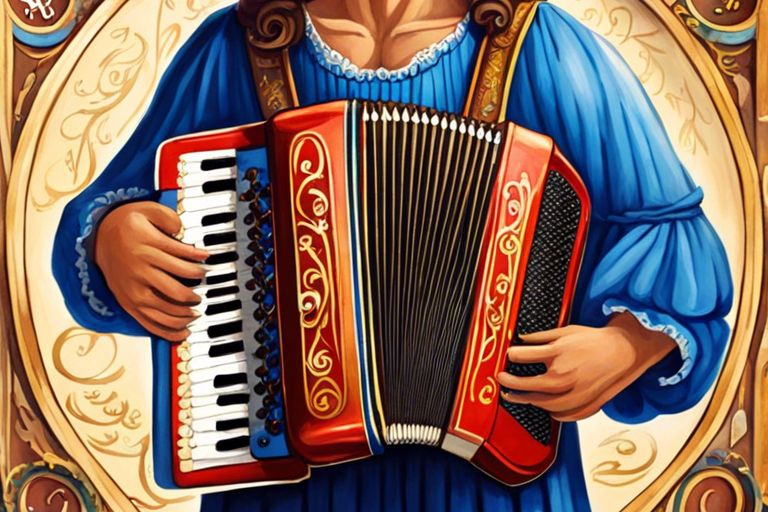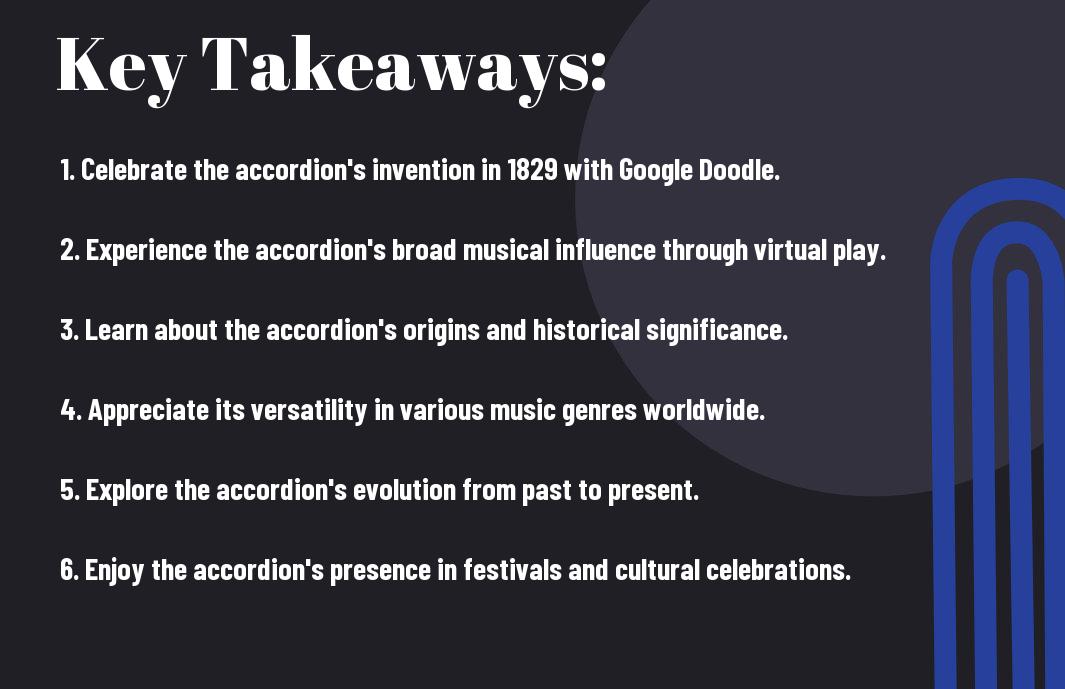Accordion Google Doodle : With the Google Doodle celebrating the accordion’s musical legacy, today’s interactive tribute allows users to virtually play this beloved instrument. From its invention in 1829 to its influence across various genres, the accordion’s versatility has captivated musicians worldwide. Learn about its historical significance and discover the magic of playing the accordion on Google Doodle today. Embrace the melodic charm and immerse yourself in the musical journey of this iconic instrument!
Play the Accordion on Google Doodle Today – Experience the Magic!

Key Takeaways:
- Accordion Celebration: Today’s Google Doodle celebrates the accordion’s invention in 1829 and its broad musical influence.
- Versatile Instrument: The accordion’s versatility spans across various music genres, from folk and classical to jazz and pop.
- Interactive Tribute: The Google Doodle allows users to virtually play the accordion, bringing a touch of musical fun to their web browsing experience.
- Historical Significance: The Doodle commemorates the accordion’s journey from invention to a global phenomenon since its 1829 patent.
- Evolution of Accordions: Early accordions had buttons that created entire chords, and modern versions can be played with buttons or a piano-style keyboard, and even incorporate electronic elements.
- Global Music Influence: The accordion’s use in music expanded as Europeans emigrated worldwide, and it can be heard in various music styles such as folk, tango, cajun, and more.
- Continued Tradition: The accordion remains a staple at events like Oktoberfest, influencing German celebrations and music worldwide even after 200 years.

The Accordion’s Rich History
Patenting the Accordion in 1829
History: The accordion, an instrument with a rich musical legacy, was patented in 1829, marking a significant milestone in its journey through music history. The name itself stems from the German word “akkord,” meaning “chord,” reflecting its imperative function in producing harmonic sounds. Early versions of the accordion had buttons on one side that created entire chords with each press, showcasing the innovative design behind this beloved instrument.
According to the Google Blog: “Throughout the late 1800s, manufacturers in Germany increased their accordion production due to its popularity among folk musicians across Europe. Early accordions had buttons on just one side, and each of these buttons created the sound of an entire chord. Another impressive feature is that the same button could produce two chords – one when the bellows were expanding and another when the bellows were contracting.”
The accordion’s journey: From its invention in 1829 to becoming a staple in various music genres worldwide, the accordion’s versatility and unique sound have captivated musicians and audiences alike. Its patent in 1829 laid the groundwork for its global influence, showcasing the ingenuity and creativity behind this iconic instrument.
From Folk to Global Phenomenon
An: The accordion’s evolution from a folk instrument to a global phenomenon underscores its enduring appeal and adaptability. As Europeans emigrated around the world, the accordion’s presence in diverse music genres expanded, with modern versions incorporating buttons or piano-style keyboards and even electronic elements for amplified or synthesized sounds.
From: The accordion can be heard in folk music, the Latino polka, the tango, cajun music, and more, showcasing its wide-ranging influence and ability to transcend cultural boundaries. Its presence in events like Oktoberfest highlights its role in lively celebrations and traditional music, cementing its legacy as a beloved instrument that continues to shape musical experiences even 200 years after its invention.
The Interactive Google Doodle
Virtually Playing the Accordion
Any music lover or curious mind can now explore the enchanting world of the accordion with Google’s interactive Doodle. This playful tribute not only commemorates the invention of the accordion in 1829, but also allows users to virtually play this beloved instrument right from their web browser. With just a few clicks, you can experience the unique sound of the accordion and explore its diverse musical heritage.
An accordion enthusiast or a novice musician can now easily experiment with different notes and chords, creating beautiful melodies with the simple click of a mouse. The interactive feature brings a touch of musical fun to your online experience, allowing you to appreciate the versatility and charm of this timeless instrument.
Immerse yourself in the world of music and let your creativity flow as you explore the accordion’s range of sounds and rhythms. Whether you’re a seasoned musician or a curious explorer, this interactive Doodle is sure to spark your imagination and deepen your appreciation for the accordion’s musical magic.
Commemorating its Historical Significance
Playing the accordion virtually on Google Doodle is not just about experiencing the joy of music—it’s also a tribute to the instrument’s rich history and cultural significance. With its invention in 1829 and subsequent rise to global popularity, the accordion has played an integral role in shaping various music genres and traditions.
Understanding the accordion’s historical significance allows us to appreciate its enduring legacy and the impact it has had on music worldwide. From folk and classical melodies to the vibrant sounds of jazz and pop, the accordion continues to captivate audiences and musicians alike, bridging cultures and generations through its timeless tunes.
With each note played on the virtual accordion, we not only celebrate its invention over two centuries ago but also rejoice in the enduring spirit of music and creativity that the instrument embodies. Experience the accordion’s magical melodies and begin on a musical journey through time with Google’s interactive Doodle today.
The Accordion’s Evolution
From Buttons to Piano-Style Keyboards
The accordion, a musical marvel with a history dating back to its invention in 1829, has undergone a fascinating evolution over the centuries. Your journey through the world of accordions can be traced through the transition from the early models with buttons on one side to the more modern versions featuring piano-style keyboards. The versatility of the accordion has been enhanced by this shift, allowing musicians to explore a wider range of musical possibilities.
ALSO READ : Hamida Banu: Google Doodle Celebrates India’s Wrestling Trailblazer
Incorporating Electronic Elements
The evolution of the accordion has not stopped at the introduction of piano-style keyboards. For accordion enthusiasts, the incorporation of electronic elements has opened up a whole new realm of sonic experimentation. For those venturing into the world of accordions, the ability to plug the instrument into an amplifier or create synthesized sounds adds a futuristic twist to this classic instrument. Accordions have truly embraced the digital age, pushing the boundaries of traditional music-making.
Accordions now have the option to be played with either buttons or a piano-style keyboard, and some even have both options. They also sometimes incorporate electronic elements so they can be plugged into an amplifier or create synthesized sounds. This modern integration of technology ensures that the accordion remains a relevant and adaptable instrument in today’s music landscape. From folk music to pop and everything in between, the accordion continues to find new ways to enchant listeners worldwide.
The Accordion’s Global Influence
Unlike many other instruments, the accordion has a truly global influence, transcending borders and cultures to leave its mark on music worldwide. From its invention in 1829 to its modern-day presence in a variety of music genres, the accordion has become a beloved and versatile instrument embraced by musicians and audiences alike.
Oktoberfest and German Celebrations
With its roots in German culture, the accordion plays a prominent role in celebrations like Oktoberfest, where its festive and lively sounds enhance the atmosphere of the event. Traditional German clothing, such as Dirndl dresses and lederhosen, paired with the music of the accordion, create a unique and immersive experience for attendees. The accordion’s presence at Oktoberfest highlights its enduring popularity and importance in German cultural traditions.
Music Genres and Cultural Significance
With its ability to adapt to various music genres, the accordion has gained cultural significance in diverse communities around the world. From folk and classical melodies to the vibrant sounds of jazz and pop, the accordion’s versatility knows no bounds. Its incorporation into genres like the Latino polka, the tango, and cajun music showcases the instrument’s ability to evoke emotions and create a truly immersive musical experience.
Another impressive feature of the accordion is its influence on cultural celebrations and events. Whether it’s the heartbeat of a lively festival like Oktoberfest or the soulful accompaniment to a tango performance, the accordion’s presence adds a unique and vibrant element to music and cultural experiences globally. Its ability to blend tradition with innovation and create unforgettable melodies continues to captivate audiences and musicians alike.
Summing up
With this in mind, it’s clear that the accordion holds a special place in music, with its invention dating back to 1829 and its far-reaching influence across various genres. Today’s Google Doodle celebration of the accordion not only pays homage to its historical significance but also allows users to virtually experience the magic of playing this beloved instrument. Through the interactive tribute, users can explore the unique sounds and melodies that the accordion is capable of producing, offering a fun and immersive musical experience.
The accordion’s evolution from its humble beginnings to its current status as a global phenomenon exemplifies the enduring appeal of this instrument. From its use in folk and classical music to its presence in jazz, pop, and other genres, the accordion continues to captivate audiences worldwide. The Google Doodle serves as a reminder of the accordion’s rich legacy and its ability to bring people together through the universal language of music.
As we engage with the accordion on Google Doodle today, we not only celebrate its musical prowess but also acknowledge its cultural significance. Whether it’s the spirited tunes of Oktoberfest or the soulful melodies of tango and cajun music, the accordion has become a symbol of joy, tradition, and creativity. So, as you click on that virtual accordion and let the notes flow, take a moment to appreciate the magic of this timeless instrument and the boundless possibilities it presents for musical exploration and expression.
SEE ALSO : Google’s Leap Day Doodle Marks 2024 with a Leapin’ Frog and Celestial Significance
FAQ
Q: What is the significance of today’s Google Doodle?
A: Today’s Google Doodle celebrates the accordion, highlighting its invention in 1829 and its broad musical influence.
Q: How does the accordion impact the music world?
A: The accordion’s versatility has been embraced by musicians worldwide, from folk and classical melodies to jazz and pop, making it a beloved instrument across music genres.
Q: What can users do with the interactive tribute on Google Doodle?
A: Users can virtually play the accordion through the interactive tribute on today’s Google Doodle, bringing a touch of musical fun to their web browsing experience.
Q: What is the historical background of the accordion’s patent in 1829?
A: The accordion was patented in 1829, deriving its name from the German word “akkord,” meaning “chord,” and has since become a global phenomenon in the music world.
Q: How did the accordion’s production evolve in the late 1800s in Germany?
A: Manufacturers in Germany increased accordion production in the late 1800s due to its popularity among folk musicians across Europe, leading to advancements like buttons creating entire chords and dual chord capabilities.
Q: In what music genres and events can the accordion be commonly heard today?
A: The accordion can be heard in folk music, tango, cajun music, Latino polka, and is a staple at events like Oktoberfest, influencing German celebrations and music worldwide.
Q: How has the accordion evolved in modern times?
A: Modern accordions can be played with buttons or piano-style keyboards, with some incorporating electronic elements for amplified or synthesized sounds, showcasing the instrument’s adaptability over two centuries.
